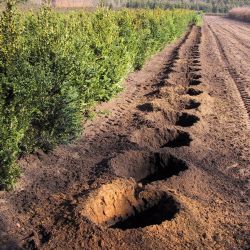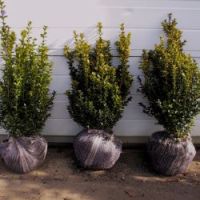Planting and soil preparation
If you want to enjoy your planting for many years, you must provide a proper soil preparation. This is essential to obtain a good soil structure. Tilling the soil has to be done when the weather is dry enough. When the soil is too wet, it can cause structural decay and the roots will not get enough oxygen. By digging deep into your plot, disruptive soil layers are broken down and the roots can grow sufficiently. In existing gardens and with limited planting it is usually not necessary to carry out deep tillage.
After digging, it is best to increase the humus content of the soil by adding green compost or potting soil. On average, you need 2 to 3 m³ of compost per acre (100 m²), depending on the nature of the soil. If the soil is too acid (low PH), it is best to add seaweed lime at a rate of 10 to 15 kg/are. Fertilising with lime will improve the soil structure and the Buxus, which is lime-loving, will grow better.
The time of planting depends on the type of plant. Plants with a root ball can be planted from October to May and plants in containers (pot-grown) can be planted throughout the season. However, you should pay attention to the following points:
Plant with root ball or wire root ball:
The root balls and roots should never dry out and should be protected from adverse weather conditions by covering or ensiling. The plants should also be covered during transport to prevent damage to the root system. You do not need to remove the gauze around the root ball. The roots will grow through it without any problems and the gauze and/or wire root ball will largely decay in the soil.
Buxus in pots:
Potting soil:
Buxus in pots require a good buxus potting soil with sufficient structure so the roots do not rot away during the winter period. When potting, a good drainage at the bottom of the pot is also very important. When in doubt, you can drill a few extra holes.
Repotting:
In principle Buxus can stay in the same pot for 3 years if you use a high-quality potting soil. After 3 years or when the growth gets worse, you should repot. This can be done by placing the plant in a larger pot. It is best to loosen the old root ball so that there is a good contact with the new potting soil.
If you want to keep the plant in the same pot, you will have to prune its roots. You can do this by making a few incisions in the root ball with an old handsaw or knife so that you can add new potting soil in the vacant spaces.
After repotting, water well and add new fertiliser.
Watering
There is no life without water and this also applies to your Buxus plants. A few watering sessions during dry periods do make a difference. The right amount of water depends on various factors such as the type of soil, whether the plants are potted and, of course, the weather conditions. Potted plants need more water than plants in the garden. Buxus and other evergreen potted plants need regular watering even in winter because evaporation will continue through the green leaves.
The following basic rules can be applied:
Planting in the garden:
In dry periods: Water sufficiently once a week
Tip: Installing a drip irrigation system is more efficient and environmentally friendly than sprinkler irrigation..
Plants in pots:
summer period: water daily, possibly via an automatic drip system.
Spring and autumn: water 2x/week, except in case of heavy rain
winter period: 1x/week, keep pot moist, not too wet.
Tip: A saucer under the pot is handy in summer because you have some water reserve that way. In winter, you should remove the tray.





